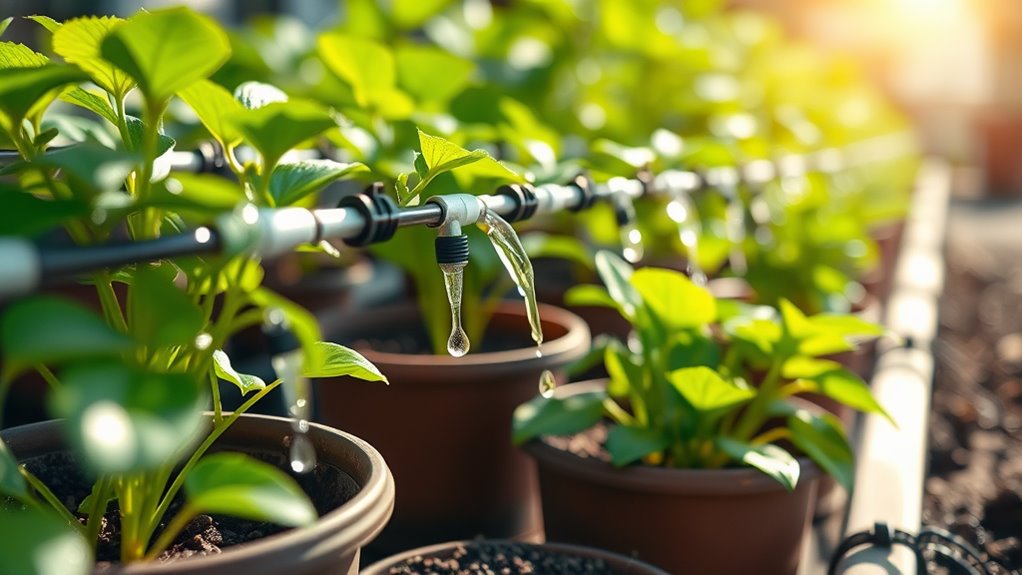Save Time With This Foolproof Watering Schedule
To save time with your watering schedule, start by evaluating your plants’ needs—check soil moisture and consider factors like species and environment. Create a simple routine based on a table: succulents every 7-14 days, houseplants every 3-7 days, and veggies daily. Use efficient tools like timers and moisture meters for easy implementation. Adjust for seasons, monitoring responses to keep plants healthy with less effort, and discover ways to customize this plan even more.
Assessing Your Plants’ Water Needs
How do you accurately assess your plants’ water needs?
Start by checking soil moisture with your finger or a meter—if the top inch feels dry, it’s time to water.
Incorporate watering schedule tips by evaluating factors like plant species, pot size, and environmental conditions such as sunlight and temperature.
Watch for signs like wilting leaves or dull color to gauge hydration accurately. Additionally, understanding optimal plant health is crucial for ensuring your plants receive the right amount of water.
This practical method guarantees you’re meeting precise requirements without overdoing it.
Creating an Effective Watering Routine
You start by accurately evaluating your plants’ needs to form the foundation of a reliable watering routine.
Next, you set a consistent schedule based on those evaluations, tailoring it to factors like soil type and weather.
This practical method helps you maintain healthy plants with minimal effort. Additionally, understanding efficient water use can further enhance your gardening practices and resources.
Assess Plant Needs
Accurately evaluating your plant’s needs establishes the backbone of an effective watering routine.
Begin by researching your plant’s specific water requirements based on its species.
Test soil moisture with your finger; if the top inch feels dry, your plant probably needs watering.
Monitor for signs of stress, including wilting, yellowing, or slow growth.
Factor in environmental factors like temperature, humidity, and light exposure to avoid over or under-watering.
Always use a consistent and reliable method for accurate assessment.
Set Routine Schedule
Once you’ve assessed your plant’s needs, build a routine schedule that aligns with those requirements for consistent care. You’ll track watering days, adjust for seasons, and use reminders to avoid overwatering. Here’s a practical guide:
| Plant Type | Frequency (Days) | Best Time |
|---|---|---|
| Succulents | 7-14 | Morning |
| Houseplants | 3-7 | Evening |
| Outdoor Veggies | 1-3 | Early Morning |
This structure guarantees efficiency and plant health.
Selecting the Right Tools for Efficiency
Efficient tools can transform your watering routine, making it quicker and more effective.
You’ll want to select a reliable timer for automatic watering, a soaker hose for even distribution, and a moisture meter to check soil needs.
Opt for durable, easy-to-use options that fit your budget, ensuring long-term efficiency.
When selecting, consider energy-efficient models that reduce water waste and enhance plant health. Additionally, using efficient watering tips can help you further streamline your gardening efforts and keep your plants thriving.
Implementing the Schedule Step by Step
Now it’s time to prepare your tools, ensuring everything from hoses to timers is ready and accessible for seamless watering. You’ll execute the steps by following the schedule you’ve set, starting with checking soil moisture before applying water. This approach keeps your plants thriving while saving you effort and resources. Additionally, establishing a consistent watering schedule can significantly enhance plant growth and minimize water waste.
Prepare Tools
Before implementing your watering schedule, gather the essential tools: a reliable watering can, a soil moisture meter, and a timer.
Make sure they’re in good condition to avoid any issues during use.
- Inspect your watering can for leaks; it’ll deliver water efficiently.
- Test the soil moisture meter’s accuracy; calibrate it properly for reliable results.
- Select a durable timer; program it easily to suit your needs.
- Organize tools in a dedicated spot; you’ll access them quickly and maintain order.
Execute Steps
With your tools prepared, you’ll execute the watering schedule by following a simple, step-by-step process that guarantees your plants thrive without waste.
First, consult your plan to identify today’s watering needs.
Gather tools for each plant type.
Water precisely at scheduled times, applying the exact amounts.
Monitor soil moisture immediately after, noting any changes.
Adjust future steps based on observations to optimize results.
Adjusting for Seasonal Variations
As temperatures fluctuate with the seasons, you’ll find that your plants’ water needs shift dramatically.
Watering more frequently in the hot summer to combat evaporation, while scaling back in cooler months to prevent root rot.
Fine-tune your routine with these tips:
- In summer, water deeply every 3-4 days to sustain roots.
- During fall, reduce to weekly sessions as growth slows.
- In winter, check soil weekly and water sparingly if needed.
- For spring, ramp up gradually as temperatures rise and plants awaken.
Additionally, understanding specific needs of plants can help you create a more effective watering schedule tailored to your garden’s unique environment.
Monitoring and Optimizing Over Time
Once you’ve adjusted for seasonal changes, you track your plants’ responses by checking soil moisture weekly and noting any signs of stress, such as wilting or yellowing leaves, to refine your watering schedule for long-term health. To fine-tune, refer to this table for common signs and adjustments—it guides your actions precisely.
| Sign | Action |
|---|---|
| Wilting leaves | Check moisture and water if dry |
| Yellowing leaves | Reduce watering if soil is wet |
| Healthy growth | Maintain current schedule |

